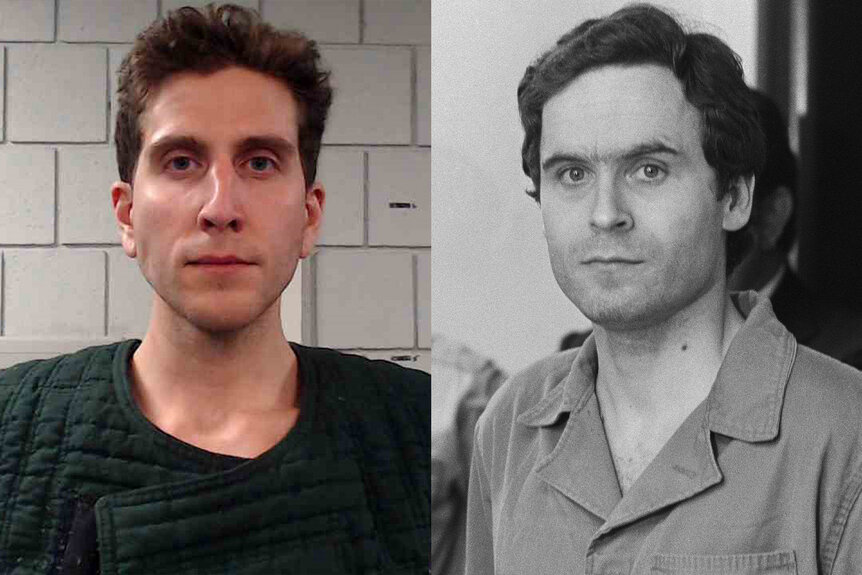Create a free profile to get unlimited access to exclusive videos, breaking news, sweepstakes, and more!
Why Are People Comparing University of Idaho Murder Suspect Bryan Kohberger to Ted Bundy?
Pointing to mugshots and clues about the crimes themselves, observers have been drawing parallels between killings that occurred more than 40 years apart.

The brutal murders last fall of four University of Idaho students, along with the subsequent arrest of their accused killer, has generated sensational interest both in the small college town where the tragic killings took place, as well as across the nation — not only for the shocking nature of the crime itself, but also for the unique details that appear to surround the case.
In the early morning hours of Nov. 13, 2022, the four students — Xana Kernodle, 20; Ethan Chapin, 20; Kaylee Goncalves, 21; and Madison Mogen, 21 — all were slain inside a rented off-campus home in the northern Idaho city of Moscow. The three female victims lived in the house while Chapin, Kernodle’s boyfriend, was staying there overnight as a guest. Two other female roommates also resided at the three-story, six-bedroom home where the killings took place, but were not targeted or harmed in the attack.
After a weeks-long search, federal and state police arrested 28 year-old Bryan Kohberger on Dec. 30 at his parents’ home in Pennsylvania, some 2,500 miles from the Idaho crime scene. Kohberger was charged with four counts of first-degree murder and a single count of burglary, appearing for the first time in a Pennsylvania courtroom on Jan. 3, 2023, where he waived his right to an extradition hearing and was subsequently transported back to Idaho.
As information about Kohberger began to emerge, his mugshot and candid court arrival photos began circulating across media, leading many observers — especially those who’ve shared their interest in the case online — to draw comparisons between Kohberger and notoriously prolific 1970s serial killer Ted Bundy. While Kohberger remains a suspect and has denied responsibility for the killings, Bundy was tried and later executed in connection with the 1978 murder of two college students in Florida — though his alleged years-long killing spree yielded evidence that tied him to many more deaths.
Who is Bryan Kohberger?
The lone suspect investigators have identified in the murders, Kohberger grew up in Pennsylvania, attending high school in the community of Pleasant Valley not far from the state’s border with New Jersey. Holding an associate degree in psychology, Kohberger completed a graduate degree program in Criminal Justice from Pennsylvania’s DeSales University in 2022 and was a Ph.D student in Criminology at Washington State University at the time of the Nov. 13 murders.
Police have confirmed that Kohberger most recently was a resident of Pullman, Washington, the city where WSU is located and less than 10 miles from the scene of the Moscow, Idaho tragedy, according to The Idaho Statesman. That same report notes that Kohberger had no criminal history, save for a 2022 seat belt infraction, at the time of his arrest. Months before the murders, Kohberger actually had applied to be an intern at the Pullman Police Department, writing in his application that he wanted to “assist rural law enforcement agencies with how to better collect and analyze technological data in public safety operations.”
Described by acquaintances and his public defender as both intelligent and eager to fit in, Kohberger reportedly brought up the murders in conversation with a neighbor in Pullman while the investigation was ongoing. After he was apprehended, he reportedly demonstrated calmness in understanding the charges against him, as well as confidence that he would be exonerated as a suspect.
Both Kohberger and Bundy were college educated
While Bundy was a convicted murderer, Kohberger remains only a suspect in the crimes for which he’s been accused. Both, though, have personal histories that reflect an intellectual interest in the inner workings of criminal investigations and criminal psychology.
After a handful of abandoned attempts at attending various colleges, Bundy graduated in 1972 from the University of Washington with a degree in psychology, the same subject Kohberger later studied. A former girlfriend recalled Bundy’s early fascination with the subject as a topic of conversation; he even worked as a Washington undergraduate at the Suicide Hotline Crisis Center in Seattle. While on staff there, Bundy talked callers through mental and emotional crises and made the acquaintance of eventual book author Ann Rule, who would go on to publish her account of Bundy’s criminal activity in "The Stranger Beside Me" (1980).
RELATED: Professor Shares How Deep Dive Into Ted Bundy’s Past Revealed His Propensity For Violence
The extent of Bundy’s 1970s serial spree may never be fully known, though it spanned years and claimed a trail of victims that appear to reveal his affinity for targeting young, college-age females. That predilection bears an affinity with the 2022 Idaho murders, in which all four victims — three of them female — also were college students.
Kohberger’s undergraduate studies focused on psychology also, first at Northampton Community College in Bethlehem, Pennsylvania, where he obtained a 2018 associate degree in the subject; and later at the private Catholic DeSales University, where he eventually earned his master’s degree in Criminal Justice.
“In my 10 years of teaching, I’ve only recommended two students to a Ph.D. program and he was one of them,” DeSales associate professor Michelle Bolger confided to the UK’s Daily Mail after Kohberger’s arrest. “He was one of my best students — ever. Everyone is in shock over this.”
Like the Idaho murders, Bundy’s attacks featured up-close trauma
Bundy infamously stalked his victims, studying their movement patterns and behaviors before closing distance in brutal fashion. The 1978 attack in Tallahassee, Florida that led to his arrest left two female students dead and two others severely injured, and showed evidence of what would later emerge as Bundy’s reportedly preferred manner of killing: intimately close-up contact with his victims that allowed him to sexually assault, bludgeon, and strangle them.
RELATED: Did Ted Bundy's Murder Spree Begin With Two College Girls In New Jersey?
Similarly, the four students who died in the Idaho attacks all bore wounds indicative of up-close traumatic violence. Firearms — often used at range — don’t appear to have been a factor in their manner of death; rather, each was stabbed repeatedly inside the rental home. Police later said they linked Kohberger to the murders after discovering DNA on a leather knife sheath that had been left behind on Mogen’s bed.
Mugshot comparisons between Bundy and Kohberger
For many online observers, the most easily accessible comparison between Bundy and Kohberger has stemmed from the release of Kohberger’s mugshot and Jan. 3 Pennsylvania court appearance.
Following Kohberger’s arrest, social media users quickly shared their observations like this one comparing Kohberger’s clean-cut short hair and drawn facial features with those of Bundy in their respective mugshots. Each appears in their police photo with similarly styled hair, gaunt cheeks, straightforward gazes beneath high arched eyebrows, and thin-set lips above strongly-protruding chins.
Those comparisons extended even beyond social media and into the professional realm, with former Bundy defense attorney John Henry Browne highlighting his own comparisons between the nature of Bundy’s crimes and speculation about the alleged killer in the Idaho case.
Comparing the Idaho crime scene to a “de facto sorority house” like the Chi Omega house where Bundy killed two Florida State University females in 1978, Browne said both cases appear to reflect the random targeting of a killer compelled not by a singular fixation on a particular victim, but by a craving to exert control.
“Just the randomness of it is actually something that does stand out,” he told Fox News Digital. “Of course, most of Ted's misbehavior was random. There were times when Ted would follow people and then decide not to kill them. And that was his way of exercising his grandiosity, you know, ‘I can control life here and there.’”



























